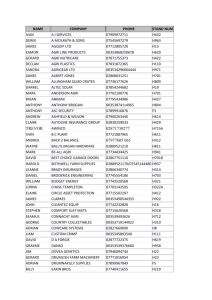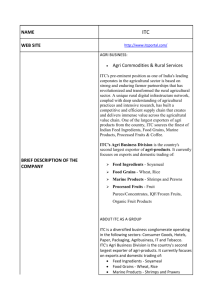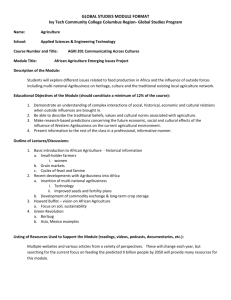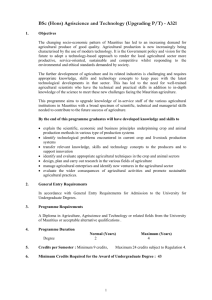Word - University of Mauritius
advertisement
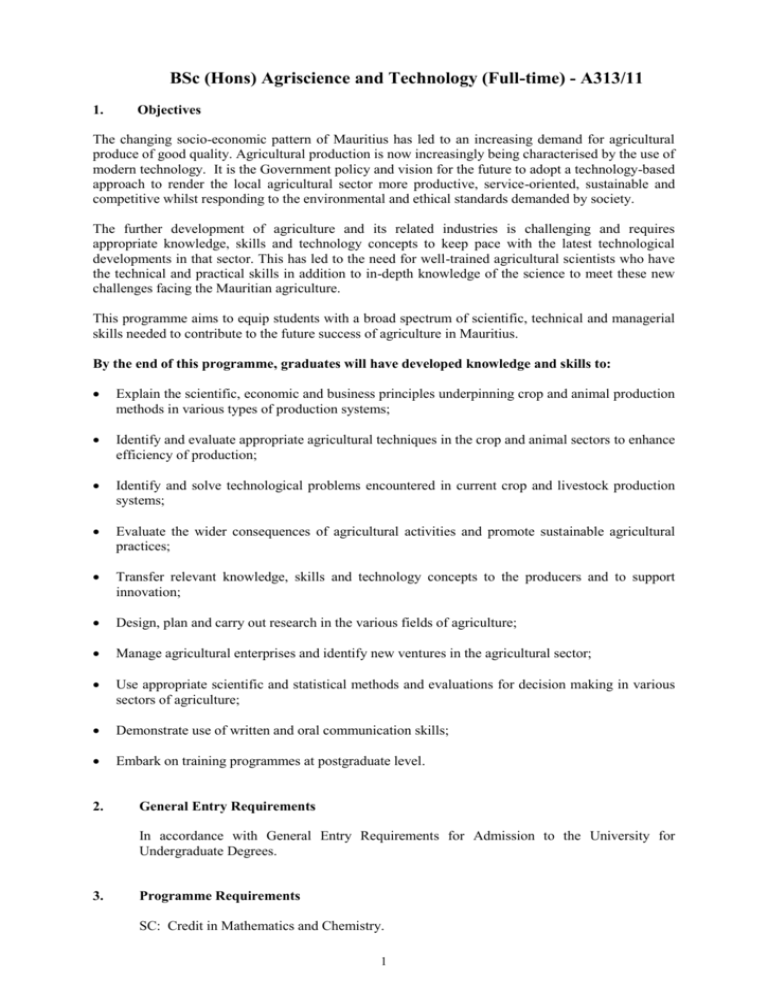
BSc (Hons) Agriscience and Technology (Full-time) - A313/11 1. Objectives The changing socio-economic pattern of Mauritius has led to an increasing demand for agricultural produce of good quality. Agricultural production is now increasingly being characterised by the use of modern technology. It is the Government policy and vision for the future to adopt a technology-based approach to render the local agricultural sector more productive, service-oriented, sustainable and competitive whilst responding to the environmental and ethical standards demanded by society. The further development of agriculture and its related industries is challenging and requires appropriate knowledge, skills and technology concepts to keep pace with the latest technological developments in that sector. This has led to the need for well-trained agricultural scientists who have the technical and practical skills in addition to in-depth knowledge of the science to meet these new challenges facing the Mauritian agriculture. This programme aims to equip students with a broad spectrum of scientific, technical and managerial skills needed to contribute to the future success of agriculture in Mauritius. By the end of this programme, graduates will have developed knowledge and skills to: Explain the scientific, economic and business principles underpinning crop and animal production methods in various types of production systems; Identify and evaluate appropriate agricultural techniques in the crop and animal sectors to enhance efficiency of production; Identify and solve technological problems encountered in current crop and livestock production systems; Evaluate the wider consequences of agricultural activities and promote sustainable agricultural practices; Transfer relevant knowledge, skills and technology concepts to the producers and to support innovation; Design, plan and carry out research in the various fields of agriculture; Manage agricultural enterprises and identify new ventures in the agricultural sector; Use appropriate scientific and statistical methods and evaluations for decision making in various sectors of agriculture; Demonstrate use of written and oral communication skills; Embark on training programmes at postgraduate level. 2. General Entry Requirements In accordance with General Entry Requirements for Admission to the University for Undergraduate Degrees. 3. Programme Requirements SC: Credit in Mathematics and Chemistry. 1 2 GCE 'A' Level passes in related approved Science subjects (Mathematics, Chemistry, Physics, Biology, Food Studies, Botany, Zoology, Computer Science or Computing). 4. Programme Duration Normal (Years) 3 Degree: Maximum (Years) 5 5. Credits per Year: Minimum 18 credits, Maximum 48 credits subject to Regulation 4. 6. Minimum Credits Required for Award of Undergraduate Degree: 104 Breakdown as follows: Degree Core Modules 89 Credits from Project 9 GEM 6 The Practical Training Component and the “Scientific Communication Skills” module must be completed satisfactorily for the award of the degree. Students may exit with (a) (b) 7. a Certificate after having earned 30 credits in core modules. a Diploma after having earned 60 credits in core modules. Assessment Each module will be assessed over 100 marks (i.e. expressed as %) with details as follows (unless otherwise specified): Assessment will be based on a Written Examination of 2-3 hour duration, carrying a weighting of 70%, and Continuous Assessment carrying 30% of total marks for AGRI modules. Modules from other Faculties/Departments/Centres will carry weighting in the Written Examination and the Continuous Assessment as specified by the concerned Faculties/Departments/Centres. Continuous Assessment will be based on laboratory/field works, and/or assignments, and should include at least 1 class test. Written examinations for all AGRI modules will normally be carried out at the end of the academic year. An overall total of 40% for combined Continuous Assessment and Written Examination would be required to pass a module, without minimum thresholds within the individual Continuous Assessment and Written Examination. Modules will carry the weightings of 1, 3 or 5 depending on their status (Introductory, Intermediate or Advanced). Weighting for a particular module is indicated within parentheses in the module code. Each module will carry credits in the range of 3 to 6. Project will carry 9 credits. Assessment of practical training will be based on the on-site supervisor’s evaluation and the student’s portfolio. For satisfactory completion of the practical training, a minimum of 40% should be attained. Assessment of the “scientific communication skills” module will be based on continuous assessment of students throughout the module and/or submission of a portfolio. The module 2 carries no credits. For satisfactory completion of the module, a minimum of 40% should be attained. 8. Important Note The rules as stipulated in this Programme Structure and Outline Syllabus will replace all other rules and regulations. 9. Academic Teaching in Case of an Emergency To ensure minimal disruption of normal academic teaching in case of an emergency (eg. closure of the University for more than 2 weeks), the Moodle e-Learning Platform of VCILT will be used to deliver Teaching and Learning content. Relevant learning resources will be posted on the Platform. Assignments (if any) will be submitted using the online submission box. Arrangements will be made to register students on the Moodle platform at the beginning of the academic year. 10. List of Modules Code Module Name Credits Agricultural Chemistry and Soil Science Animal Production: Principles and Techniques Agronomy and Horticultural Crop Production I Applied Economics, Extension and Systems Microbiology and Genetics Agrometeorology and Climate Change Hr / Yr L+P 45+60 30+30 45+60 60+45 60+60 45+0 AGRI 1018Y(1) AGRI 1034Y(1) AGRI 1035Y(1) AGRI 1062Y(1) AGRI 1047Y(1) AGRI 1064Y(1) AGRI 2001Y(3) AGRI 2024Y(3) AGRI 2045Y(3) AGRI 2088Y(3) AGRI 2089Y(3) AGRI 2092Y(3) AGR12093Y(3) AGRI 2100 Food Science and Technology Agricultural Engineering and Applications Statistical Methods for Agricultural Sciences Biochemistry and Biotechnology Pests, Diseases and Weeds Control Animal Production and Science I Botany and Crop Physiology Scientific Communication Skills 45+30 60+45 60+60 60+60 45+60 60+60 60+45 20+0 4 5 6 6 5 6 5 AGRI 3000Y(5) AGRI 3003Y(5) AGRI 3026Y(5) AGRI 3051Y(5) 60+60 60+45 60+30 9 6 5 5 AGRI 3085Y(5) AGRI 3086Y(5) Project Animal Science and Production II Crop Production Technologies Postharvest Management and Agricultural Produce Processing Agricultural Management and Marketing Entrepreneurship for Small and Medium Agribusiness 60+45 45+30 5 4 AGRI 2000 Practical Training can be undertaken either in Year 1 or in Year 2 GEM (1) - Total No. of credits : 104 3 5 3 5 5 6 3 6 Programme Plan – BSc (Hons) Agriscience and Technology 11. YEAR 1 Code AGRI 1018Y(1) AGRI 1034Y(1) AGRI 1035Y(1) AGRI 1062Y(1) AGRI 1047Y(1) AGRI 1064Y(1) Module Name Agricultural Chemistry and Soil Science Animal Production: Principles and Techniques Agronomy and Horticultural Crop Production I Applied Economics, Extension and Systems Microbiology and Genetics Agrometeorology and Climate Change GEM(1) Hr / Yr L+P 45+60 30+30 45+60 60+45 60+60 45+0 Credits 5 3 5 5 6 3 - 6 45+30 60+45 60+60 60+60 45+60 60+60 60+45 20+0 4 5 6 6 5 6 5 60+60 60+45 60+30 9 6 5 5 60+45 45+30 5 4 YEAR 2 AGRI 2001Y(3) AGRI 2024Y(3) AGRI 2045Y(3) AGRI 2088Y(3) AGRI 2089Y(3) AGRI 2092Y(3) AGR12093Y(3) AGRI 2100 Food Science and Technology Agricultural Engineering and Applications Statistical Methods for Agricultural Sciences Biochemistry and Biotechnology Pests, Diseases and Weeds Control Animal Production and Science I Botany and Crop Physiology Scientific Communication Skills YEAR 3 AGRI 3000Y(5) AGRI 3003Y(5) AGRI 3026Y(5) AGRI 3051Y(5) AGRI 3085Y(5) AGRI 3086Y(5) Project Animal Science and Production II Crop Production Technologies Postharvest Management and Agricultural Produce Processing Agricultural Management and Marketing Entrepreneurship for Small and Medium Agribusiness AGRI 2000 Practical Training can be undertaken either in Year 1 or in Year 2 Total number of credits : 104 4 12. Outline Syllabus AGRI 1018Y(1) - AGRICULTURAL CHEMISTRY AND SOIL SCIENCE Agrochemicals, their properties, metabolism, and mode of action. Chemistry of fertilisers: straight, complex, compound mixed, blended fertilisers. Fertiliser solutions. Foliar fertilisers. Manures, municipal sewage, compost. Chemistry of pesticides: organochlorines, organophosphates, carbamates, pyrethroids, dinitrophenols, phthalimides, substituted ureas, triazines, inorganics, botanical pesticides, bio-pesticides. Analysis of pesticides and fertlisers. Soil as a natural body. Weathering. Factors and processes in soil formation. Physical, physiochemical, biological and mineralogical properties of soil. Soil profile. Soil air. Water, temperature, soil organic matter and soil organisms. Concepts of soil fertility and land suitability. Soil taxonomy. Soil biology. Soil amendments. Soil pollution. Heavy metals. Polyaromatic hydrocarbons (PAH), persistent organic pollutants (POP) in soils. Soil bioremediation. AGRI 1034Y(1) - ANIMAL PRODUCTION: PRINCIPLES AND TECHNIQUES Fundamentals of animal management and production: nutrition; feeds and feeding; reproduction and breeding; animal welfare and health; housing and equipment; animal-environment interactions. Introduction to farm animal industries, breeds of animal, their products and by-products: matching production of quality and safe food with protection and care of the environment. Fundamental skills of animal husbandry: rationing; weighing and tagging; usage of preventive and diagnostic equipment; evaluation of body condition score; use and development of performance records. Evaluation of Animal behaviour. Animal housing evaluation. AGRI 1035Y(1) - AGRONOMY AND HORTICULTURAL CROP PRODUCTION I Principles of field crop agronomy. Crop-environment interactions. Cropping systems. Crop propagation. Plant Nutrition. Nutrient deficiency symptoms and their corrections. Nutrient requirements and fertiliser recommendations for specific crops / cropping systems. Applied crop physiology. Husbandry and production of economically important horticultural crops. Field operations and techniques in crop production. AGRI 1062Y(1) - APPLIED ECONOMICS, EXTENSION AND SYSTEMS Agricultural economics: demand and supply; principles of production economics. Introduction to agricultural systems concepts: holistic approach to agriculture. Introduction to agricultural extension. An overview of farming systems in the world with particular reference to the SADC region. Agricultural and food policies. Structure and organisation of local agricultural institutions. Agricultural extension: principles, programmes and management; Participatory Research Approach. Systems analysis and modelling; farming systems research. AGRI 1047Y(1) – MICROBIOLOGY AND GENETICS Microbiology diversity, structure, functions and economic significance. Microbial physiology. Growth and Survival. Control of microorganisms. Basic procedures and techniques in microbiological analysis. Mendelian Inheritance. Linkage and chromosome mapping. Sex linked and extra-nuclear inheritance. Quantitative and population genetics. Objectives of plant breeding. Selection techniques. Breeding of selected crops. Legislative framework. Methods of crop improvement. Genetic variation and manipulation of variability. 5 AGRI 1064Y (1) – AGROMETEOROLOGY AND CLIMATE CHANGE Economic significance and importance of weather. Radiation and surface energy balance: earth's atmosphere; atmospheric energy; atmospheric moisture and precipitation; atmospheric motion. Soil and its heat balance. Topoclimate and mesoclimate, representative observation, and their dependence on topography. Agrometeorology management at microscale and toposcale. Global climatic change and variability and its effect on agriculture: weather hazards affecting agricultural output. Weather patterns over Mauritius. Use of weather data in agriculture. Basic instrumentation in agro-meteorology. Seminar-based learning. Problem-solving and case studies on climate change mitigation and adaptation. AGRI 2001Y(3) - FOOD SCIENCE AND TECHNOLOGY Classification, chemical structure and properties of food constituents and food additives. Chemical composition, properties and nutritional value of food commodities. Primary sensory attributes of foods and perception of food quality. Physical, chemical and sensory analysis of foods. Microbial food spoilage. Useful micro-organisms. Incidence and causes of major food borne microbial diseases. Types of nutrients and their role in the human body. Healthy eating guidelines sustainable diet. Food preservation by heating, chilling, freezing, dehydration, chemicals and ionising radiation. Packaging materials. Food laws and standards. Concepts of food quality and safety. Factors which affect quality and safety. Food hazards. Process control, application of principles of food hygiene and relevant codes of practice/guidelines to ensure quality and safety. Traceability. Importance of food safety management throughout the food chain. Comprehensive food safety management systems AGRI 2024Y(3) - AGRICULTURAL ENGINEERING AND APPLICATIONS Basic engineering science relevant to agriculture, soil systems and water. Soil tillage. Agricultural machinery: tractors, rotovators, mechanical planters and harvesters, and fertigators. Tractor Technology. Field mechanisation. Pesticide sprayers and fertiliser applicators. Water logging and drainage. Introductory remote sensing, and GIS. Irrigation systems: Equipment and operation. Soil moisture and soil moisture characteristic curves. Evapotranspiration and net water requirements. Soil water movement. Infiltration rate. Hydraulic conductivity of soil. Nuclear methods of soil moisture determination. Irrigation systems: surface, overhead irrigation and drip irrigation. Planning and design of various irrigation systems based on soil-water plant climate relationships. Use and maintenance of irrigation systems. Farm structures and farm buildings. Farm roads. Waste management technology. . Introduction to controlled environment technology: control of temperatures, humidity, light and other variables in agricultural, including livestock buildings and horticultural building and the instrumentation connected therewith. AGRI 2045Y(3) - STATISTICAL METHODS FOR AGRICULTURAL SCIENCES Introducing statistics in agriculture. Descriptive statistics – displaying and summarising data. Probability distributions. Point and interval estimation. Hypothesis testing. Analysis of Categorical data. Correlation and regression analysis. Design and analysis of experiments: Principles of agricultural experimentation. Analysis of variance. Completely randomised design, Randomised block design, Latin square design. Factorial treatment structure. Non-parametric methods. Data entry and analysis using EXCEL and MINITAB. 6 Introduction to research methodology. Qualitative and quantitative research. Sampling methods. Questionnaire development, design and administration. Data coding and processing using SPSS. Elements of scientific and technical writing. AGRI 2088Y(3) - BIOCHEMISTRY AND BIOTECHNOLOGY Structure and functions of cells and organelles; Biomolecules: Polysaccharides, sugars; storage polysaccharides; Lipids, classification and properties, biological membranes; Proteins, amino acids, covalent and three-D structure of proteins; Enzymes, properties and mechanism of actions, enzyme kinetics; Metabolic pathways, thermodynamics, Energy metabolism: pathways respiration and ATP synthesis. Photosynthesis. Nucleic acids and protein synthesis. Concept and basis of biotechnology. Application of biotechnology in agriculture and food science. Cell and tissue culture technology. Crop improvement through the application of new techniques. . Genetic improvement of crops for introduction of new genes: their evaluation and potential risks. Managing plant and animal diseases: use of molecular methods of pathogen diagnosis, characterization and monitoring. Transgenic animals. Animal embryo transfer and associated techniques. Cloning. Vaccine development. Legislative framework. AGRI 2089Y(3) - PESTS, DISEASES AND WEEDS CONTROL Taxonomy, systematic, biology, ecology and economic importance of pests, plant pathogens and weeds affecting crops. Control and management of pests, diseases and weeds of crop plants. Concept and principles of IPM. Biological, physical, chemical, cultural, biology-based, genetic, biotechnological and legal methods of pest control. Botanical pesticides and biopesticides. Pestresistant transgenic crops (GMOs). Economics of crop protection. Quarantine for plant health and biological control agents; pest-free areas; Sanitary & phytosanitary issues; the SPS Agreement of the WTO; Pest risk assessment, surveillance and mitigation; Phytosanitary inspection, quarantine treatments and disposal of plants/produce; Standards, certification and legislation. Climate change and crop protection. GIS and Remote Sensing for crop protection. AGRI 2092Y(3) - ANIMAL PRODUCTION AND SCIENCE 1 Aspects of physiological processes in growth and development, digestion, reproduction, lactation, egg laying. Meat science: carcass composition and quality, pre and post mortem muscle metabolism. Key concepts in thermal balances in farm animals. Livestock and climate change: impacts on grasslands, biodiversity, health. Digestive physiology and metabolism of end products of digestion. Factors regulating feed intake. Feed evaluation. Feeding standards and their applications. Feed formulation: manual and computerised procedures. Legislative framework for feed manufacture. Basic principles of qualitative and quantitative genetics. Main selection methods and genetic responses. Concepts of correlated selection response, heterosis and crossbreeding system. Natural and acquired immunity. Disease causing agents. Major pests and diseases of farm animals and their control. Veterinary Public health and food borne and zoonootic diseases. Disease surveillance and Animal health schemes. AGRI 2093Y(3) - BOTANY AND CROP PHYSIOLOGY Classification, identification, morphology, ecology and uses of economically important crops. Environmental influences on crop growth and development. Vegetative and reproductive plant physiology. Plant water relationships. Plant growth substances. Plant growth analysis. Yield determination and crop productivity. 7 Seed physiology. Growth kinetics and Introductory Crop Modelling . Light and plant development: photomorphogenesis and photoperiodism. Source-sink relationship. Photosynthate partitioning in relation to yield. Modification of yield potential by chemical and cultural means. Senescence. Stress physiology. Essential plant nutrients: forms, functions, deficiency symptoms, and corrections. Water and plant mineral uptake. Assimilation of inorganic nutrients. Plant tissue analysis. Problem-solving and case-studies on plant mineral deficiencies/ toxicities and plant stress management. AGRI 2100 - SCIENTIFIC COMMUNICATION SKILLS Avenues of communication in science. Scientific and technical writing. Oral and poster presentations. Ethics of scientific publishing. The dissertation guidelines. Planning and managing the dissertation writing up process – effective literature search and review, introduction, methodology, results, discussion, conclusions, referencing rules and plagiarism. AGRI 2000 - PRACTICAL TRAINING Students are required to undergo a full-time practical training of 6-8 week duration during the winter vacation, either in year 1 or in year 2. The practical training placement may take place in the various agricultural institutions and industries in the private or public sector. The aim is to contextualise learning within real-life work environments related to your course. Students are required to submit a training placement portfolio. This module does not carry any credit, but training must be completed satisfactorily for the award of the degree. AGRI 3000Y(5) – PROJECT This is a very important component of the programme, allowing students to develop high level skills and cognitive abilities. Every student will be allocated a research topic and the research work will be carried out under supervision. The student is required to investigate a topic/problem, plan and execute the research work as well as present and discuss the results. The student will have to submit a dissertation at the end of the final year. Students should demonstrate good practice in using skills and knowledge acquired and follow guidelines as laid down. AGRI 3003Y(5) - ANIMAL SCIENCE AND PRODUCTION II Principles of managing animals in typical production systems for biological and economic sustainability: poultry (meat, eggs, other avian species); pigs; rabbits; deer; goats and sheep; beef and dairy cows. Meeting the challenge of climate change: adaptation and mitigation livestock strategies. Food chain management from primary production to consumer use. Management of disease risks. Trends and current issues related to production and consumption of animal products: meeting the needs of a global market and public concerns. Principles and their applications in the efficient and profitable production of poultry meat and eggs, and pig meat. Nutrition, housing and equipment, prevention and control of diseases, environment care and waste management. Preslaughter and postslaughter effects on meat quality and composition and hygienic practices to ensure quality and safety of carcass. Welfare considerations in farm animal production setting. AGRI 3026Y(5) - CROP PRODUCTION TECHNOLOGIES Mechanised vegetable crop production. Plant characteristics for mechanised crop production. Soil conditioning for vegetable production. Seed priming and enhancement. Fluid drilling. Direct sowing for crop establishment. Plug production. Mechanical transplanting. Plastic mulching in horticulture. 8 New trends in vegetable crop production. Good agricultural practices in crop production. Tissue Culture technologies for crop improvement. Cropping and production of high value horticultural crops in plastic tunnels, shade houses and greenhouses. Types of structures for protected cultivation and their characteristics. Greenhouse design and site considerations. Greenhouses and their operation. Plant culture in hydroponics. Plant nutrition in Soilless Culture. Hydroponics media. Hydroponics systems. Cropping and production of selected vegetables, fruits and ornamentals in soilless culture systems: water culture systems and substrate culture systems. Aeroponics. AGRI 3051Y(5) - POSTHARVEST MANAGEMENT AND AGRICULTURAL PRODUCE PROCESSING Climacteric and non-climacteric produce. Post-harvest physiology. Post-harvest crop losses and their reduction. Packaging. Quality and safety of fresh horticultural products. Minimal processing of horticultural products. Processing of fruits, vegetables, milk, egg, meat, poultry and seafood products. AGRI 3085Y(5) - AGRICULTURAL MANAGEMENT AND MARKETING Business principles applied to a farm enterprise/agroindustry. Agricultural management: framework of farm management. Farm Planning Techniques: Budgeting and Linear programming. Strategic decision-making in agribusiness. Managing human resources. Business control. Analysis of farming results. Project planning and investment decisions. Agricultural marketing: marketing functions; marketing channels and costs. Advanced agricultural and food marketing. International agricultural trade Emerging issues and challenges. AGRI 3086Y(5) - ENTREPRENEURSHIP FOR SMALL AND MEDIUM AGRIBUSINESS Risk and Uncertainty in agribusiness. Agribusiness finance. Financial information. The entrepreneurial attitude: generation of business ideas and innovation; opportunities for setting up an agribusiness. Types of business organisations. Business strategy in agribusiness firms. Public and private sector support in Mauritius. Setting up an agribusiness unit and development of a business plan. Clustering. Business Incubators. Case studies of agribusinesses at national, regional and international levels. 9

